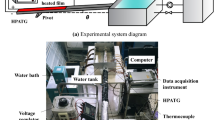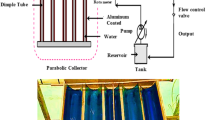Abstract
A mathematical model was developed to predict the maximum heat transfer capacity of high temperature heat pipe with triangular grooved wick. The effects of the inclination angle and geometry structure were considered in the proposed model. Maximum heat transfer capacity was also investigated experimentally. The model was validated by comparing with the experimental results. The maximum heat transfer capacity increases with the vapor core radius increasing. Compared with the inclination angle of 0°, the maximum heat transfer capacity increases at the larger inclination angle, and the change with temperature is larger. The performance of heat pipe with triangular grooved wick is greatly influenced by gravity, so it is not recommended to be applied to the dish solar heat pipe receiver.
Similar content being viewed by others
References
XU Hui, ZHANG Hong, BAI Tong, DING Li, ZHUANG Jun. Development and heat transfer analysis of high temperature heat pipe solar receiver [J]. Acta Energiae Solaris Sinica, 2010, 31(12): 1585–1590. (in Chinese)
BAI Tong, ZHANG Hong, XU Hui. Application of high temperature heat pipe in hypersonic vehicles thermal protection [J]. Journal of Central South University of Technology, 2011, 18(4): 1278–1284.
WANG Cheng-long, GUO Zhang-peng, ZHANG Da-lin, QIU Sui-zheng, TIAN Wen-xi, WU Ying-wei, SU Guang-hui. Transient behavior of the sodium-potassium alloy heat pipe in passive residual heat removal system of molten salt reactor [J]. Progress in Nuclear Energy, 2013, 68: 142–152.
WANG Cheng-long, ZHANG Da-lin, QIU Sui-zheng, TIAN Wen-xi, WU Ying-wei, SU Guang-hui. Study on the characteristics of the sodium heat pipe in passive residual heat removal system of molten salt reactor [J]. Nuclear Engineering and Design, 2013, 265: 691–700.
GUI Xiao-hong, TANG Da-wei, LIANG Shi-qiang, LIN Bin, YUAN Xiu-gan. Influence of void ratio on thermal performance of heat pipe receiver [J]. International Journal of Heat and Fluid Flow, 2012, 33(1): 109–117.
SHABGARD H, BERGMAN T L, SHARIFI N, FAGHRI A. High temperature latent heat thermal energy storage using heat pipes [J]. International Journal of Heat and Mass Transfer, 2010, 53(15/16): 2979–2988.
ZHANG Hong, ZHUANG Jun. Research, development and industrial application of heat pipe technology in China [J]. Applied Thermal Engineering, 2003, 23(9): 1067–1083.
ZENG Min, MA Ting, SUNDEN B, TRABIA M B, WANG Qiu-wang. Effect of lateral fin profiles on stress performance of internally finned tubes in a high temperature heat exchanger [J]. Applied Thermal Engineering, 2013, 50(1): 886–895.
LAUBSCHER R, DOBSON R T. Theoretical and experimental modelling of a heat pipe heat exchanger for high temperature nuclear reactor technology [J]. Applied Thermal Engineering, 2013, 61(2): 259–267.
TSAI Te-en, WU Guan-wei, CHANG Chih-chung, SHIH Wen-pin, CHEN Sih-li. Dynamic test method for determining the thermal performances of heat pipes [J]. International Journal of Heat and Mass Transfer, 2010, 53(21/22): 4567–4578.
HUNG Y M, TIO K K. Thermal analysis of optimally designed inclined micro heat pipes with axial solid wall conduction [J]. International Communications in Heat and Mass Transfer, 2012, 39(8): 1146–1153.
TAO Han-zhong, ZHANG Hong, ZHUANG Jun. Progress in the theoretical study on miniature axial grooved heat pipe [J]. Chemical Industry and Engineering Progress, 2010, 29(3): 403–412. (in Chinese)
KIM S J, SEO J K, DO K H. Analytical and experimental investigation on the operational characteristics and the thermal optimization of a miniature heat pipe with a grooved wick structure [J]. International Journal of Heat and Mass Transfer, 2003, 46(11): 2051–2063.
LI Ting-han, LI Jing-dong, CAO Li-ming, XIANG Li-cheng. Steady-state modelling and experimental investigation of micro heat pipes [J]. Chinese Space Science and Technology, 1997 (6): 22–27. (in Chinese)
CHEN Yong-ping, ZHU Wang-fa, ZHANG Cheng-bin, SHI Ming-heng. Thermal characteristics of heat pipe with axially swallow-tailed microgrooves [J]. Chinese Journal of Chemical Engineering, 2010, 18(2): 185–193.
CHEN Yong-ping, ZHANG Cheng-bin, SHI Ming-heng, WU Jin-feng, PETERSON G P. Study on flow and heat transfer characteristics of heat pipe with axial “Ω” shaped microgrooves [J]. International Journal of Heat and Mass Transfer, 2009, 52(3/4): 636–643.
HUNG Y M, SENG Q, Effects of geometric design on thermal performance of star-groove micro-heat pipes [J]. International Journal of Heat and Mass Transfer, 2011, 54(5/6): 1198–1209
THUCHAYAPONG N, NAKANO A, SAKULCHANGSATJATAI P, TERDTOON P. Effect of capillary pressure on performance of a heat pipe: Numerical approach with FEM [J]. Applied Thermal Engineering, 2012, 32: 93–99.
LI Jin-dong, LI Ting-han. Two-dimensional modelling and experimental verification for inner flow and heat transfer of heat pipes [J]. Chinese Space Science and Technology, 1997 (3): 9–14. (in Chinese)
KIHM K, KIRCHOFF E, GOLDEN M, ROSENFELD J, RAWAL S, PRATT D, SWANSON A, BILHEUX H, WALKER L, VOISIN S, HUSSEY D S, JACOBSON D L. Neutron imaging of alkali metal heat pipes [J]. Physics Procedia, 2013, 43: 323–330.
BAI Tong. Development and research of combined wick with high heat transfer performance [D]. Nanjing: Nanjing University of Technology, 2011: 41. (in Chinese)
ZHU Shi-xing, WANG Zhi-qing. A study on flow resistance in the entrance region of isosceles triangular ducts [J]. Applied Mathematics and Mechanics, 1993, 14: 793–807.
FAGHRI A. Performance characteristics of a concentric annular heat pipe. Part II-Vapor flow analysis [J]. ASME Journal of Heat Transfer, 1989, 111: 851–857.
Author information
Authors and Affiliations
Corresponding author
Additional information
Foundation item: Project(51076062) supported by the National Natural Science Foundation of China
Rights and permissions
About this article
Cite this article
Shen, Y., Zhang, H., Xu, H. et al. Maximum heat transfer capacity of high temperature heat pipe with triangular grooved wick. J. Cent. South Univ. 22, 386–391 (2015). https://doi.org/10.1007/s11771-015-2533-7
Received:
Accepted:
Published:
Issue Date:
DOI: https://doi.org/10.1007/s11771-015-2533-7




